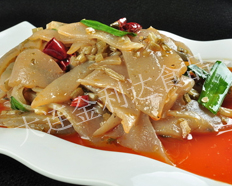
Before processing, konjak must first select raw materials. It should be noted that konjak with an individual weight of 1.0kg-1.5kg is suitable. The raw materials are too small, the maturity of refined powder is not enough, the particles are small, and the viscosity is low; If it is too large, the moisture content is higher, which increases the energy consumption of the dryer. Introduction to the wet processing steps of konjak:
Raw material sorting, soaking, peeling, screening, inspection, grading and packaging are the same as dry processing.
Color protection: use sulphurous acid solution with effective sulfur dioxide concentration of 25-100mg/l for color protection treatment, which is generally added to * * times of crushing medium.
Grinding and separation: dilute additives should be injected at the same time to control the physiological variation of the material that is easy to swell and browning after being hydrophilic.
Grinding, washing and dehydration: after these three processes, the residual additives are removed and impurities are separated again to obtain high-purity refined powder filter cake. Make the dehydrated material in the critical state of expansion, and then input it to the next process mechanically.
Drying: low temperature vacuum, hot air flow, fluidized bed, boiling and other drying methods can be adopted. Due to the large particle size and high moisture content of konjak powder, each drying process takes only a few seconds, so it cannot be completely dried at one time, and it needs to be repeated several times. After being placed for a period of time, konjak powder is subsequently baked. The wet processing steps of konjak are introduced to remove residual ethanol.
Konjak contains a large amount of mannan, vitamins, plant fiber and a certain amount of mucus protein. The nutritional value of konjak is far more than these. Therefore, our demand for konjak processing is also increasing. Process of konjak primary processing:
(1) Washing taro and crushing: put the fresh taro in clear water to wash away the soil, scrape off the skin, and then cut it into granules with a grinder or manually.
(2) Pulping: add an appropriate amount of water and X% edible alkali to the granular fresh taro (i.e. x kg fresh taro plus x kg edible alkali), and grind it into a paste with a pulper or stone mill.
(3) Cooking: there are three ways to cook the formed taro pulp: ① cooking method, that is, steaming it. The method is to pad a piece of clean cotton cloth in the steamer, cut the formed taro pulp into blocks with a knife and put it in the steamer until it is steamed thoroughly; ② Direct cooking method: put konjak paste directly into a clean iron pot and heat it until cooked. When using this method, it should be noted that the fire should not be strong when heating, and at the same time, it should be mixed while cooking to prevent scorching. The standard of its ripeness is that the leather surface is honeycomb and elastic, and the knife does not stick when cutting. After cooking, rinse to remove the residual alkali, and the utensils should not be in contact with acids, so as to avoid that mannan hydrolysis cannot solidify.









